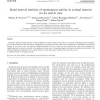55 search results - page 3 / 11 » Spike Train Correlation Visualization |
IJON
2007
13 years 5 months ago
2007
Inspired by optical recordings from visual cortex which show maps of orientation selectivity, and the finding that very similar patterns of population activity occur when the neu...
ISCAS
2003
IEEE
13 years 11 months ago
2003
IEEE
Temporally-asymmetric Hebbian learning is a class of algorithms motivated by data from recent neurophysiology experiments. While traditional Hebbian learning rules use mean firin...
IJON
2007
13 years 5 months ago
2007
Stationary spiking of single neurons is often modelled by a renewal point process. Here, we tested the underlying model assumption that the inter-spike intervals are mutually inde...
IJON
2000
13 years 5 months ago
2000
Synchronized neuronal ring has been reported in many neural systems and may play a role in the representation of sensory stimuli and the modi cation of sensory representations by ...
BC
2007
13 years 5 months ago
2007
Correlation measures are important tools for the analysis of simultaneously recorded spike trains. A well-known measure with probabilistic interpretation is the cross-intensity fun...

